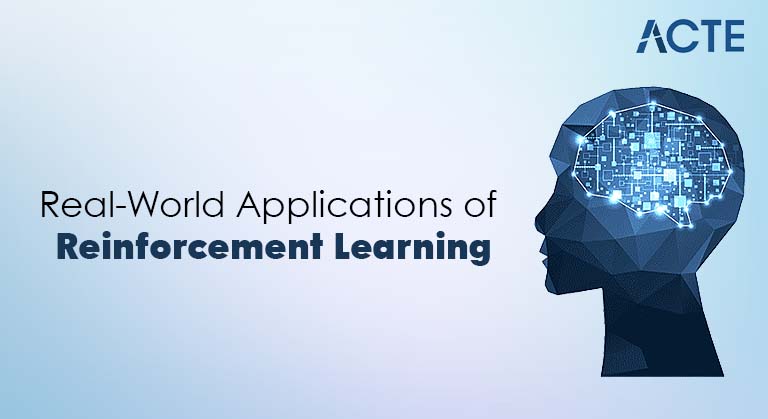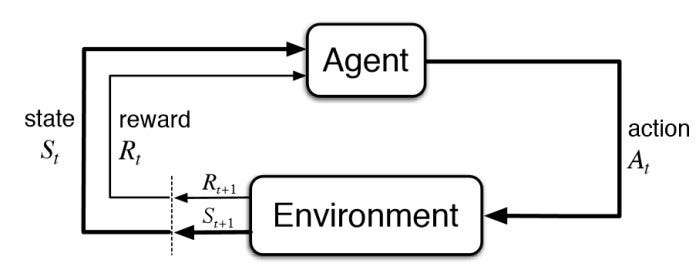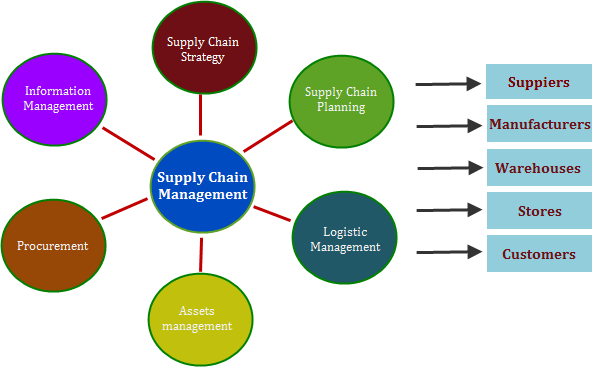
- Introduction to Reinforcement Learning
- How RL Differs from Other ML Types
- Key Concepts: Agent, Environment, Reward
- Gaming and Simulations
- Robotics and Control Systems
- LossFinance and Portfolio Optimization
- Supply Chain and Logistics
- Recommendation Systems
- Conclusion
Introduction to Reinforcement Learning (RL)
Applications of Reinforcement Learning (RL) is a type of Machine Learning Training where an agent learns to make decisions by interacting with an environment. Unlike supervised learning, where models learn from labeled data, or unsupervised learning, where the goal is to find hidden patterns in unlabeled data, RL is driven by feedback in the form of rewards or penalties. It closely mimics how humans and animals learn from experience through trial and error. RL has gained considerable attention due to its effectiveness in dynamic decision-making environments and its success in domains like gaming, robotics, and finance.Reinforcement Learning (RL), Q-learning is a branch of machine learning concerned with how agents should take actions in an environment to maximize cumulative rewards. Unlike supervised learning, where the model learns from labeled data, RL focuses on learning through interaction and feedback. An RL agent learns by exploring its environment, making decisions, and receiving feedback in the form of rewards or penalties. Over time, it adjusts its strategy known as a policy to improve performance. The core components of an RL system include the agent (the learner), the environment (where it operates), states (situations in the environment), actions (choices available to the agent), and rewards (feedback signals). The agent’s goal is to learn an optimal policy that maps states to actions in a way that maximizes long-term reward. Reinforcement learning has achieved significant success in areas such as game playing (e.g., AlphaGo), robotics, autonomous driving, and recommendation systems. It is particularly well-suited for problems involving sequential decision-making and environments where trial-and-error learning is feasible. Key algorithms in RL include Q-learning, Deep Q-Networks (DQN), and policy gradient methods. As computational power and data availability grow, Applications of reinforcement learning continues to evolve, pushing the boundaries of what intelligent systems can achieve in dynamic and uncertain environments.
Ready to Get Certified in Machine Learning? Explore the Program Now Machine Learning Online Training Offered By ACTE Right Now!
How RL Differs from Other ML Types
Reinforcement learning stands apart from other types of machine learning in its approach to learning. In supervised learning, the model learns from a dataset where the input-output mapping is known. In unsupervised learning, the system tries to identify structures and clusters within the data without labeled outputs. RL, however, involves a type of machine learning agent that takes actions in an environment to maximize cumulative rewards. This interaction creates a feedback loop where the agent observes the environment, takes actions, receives rewards, and updates its policy accordingly. The absence of fixed training data and the need to learn from interaction make RL suitable for problems involving sequential decision-making. Reinforcement Learning is grounded in the theory of Markov Decision Processes (MDPs), which provide a formal framework for modeling decision-making problems where outcomes are partly random and partly under the control of an agent. An MDP is defined by:
- States (S): All possible situations the agent can be in.
- Actions (A): The set of actions available to the agent in each state.
- Transition Function (T): The probability of moving from one state to another after taking an action.
- Reward Function (R): The immediate reward received after transitioning between states due to an action.
- Policy (π): A strategy that defines the action the agent takes in each state.
Key Concepts: Agent, Environment, Reward
The core components of any RL setup are:
- Agent: The learner or decision-maker.
- Environment: The external system the agent interacts with.
- State: A representation of the current situation of the environment.
- Action: A decision made by the agent.
- Reward: A scalar feedback signal indicating the benefit of an action.
- Policy: A strategy used by the agent to determine the next action based on the current state.
- Value Function: An estimate of expected future rewards.
- Model of the Environment (optional): Predicts the next state and reward.

The interaction is typically modeled as a Markov Decision Process (MDP), where the next state depends only on the current state and action.
To Explore Machine Learning in Depth, Check Out Our Comprehensive Machine Learning Online Training To Gain Insights From Our Experts!
Gaming and Simulations
RL gained mainstream fame through its application in games. DeepMind’s AlphaGo and AlphaZero demonstrated how RL could surpass human-level performance in games like Go, Chess, and Shogi. In these systems, RL agents use deep neural networks and techniques like Monte Carlo Tree Search (MCTS) to learn optimal strategies. Video games like Dota 2 (OpenAI Five) and StarCraft II (AlphaStar) have also been conquered by RL-based systems. These applications highlight RL’s ability to handle complex state-action spaces, delayed rewards, and multi-agent interactions. Simulations in gaming provide ideal training grounds for RL algorithms due to their controlled yet dynamic environments.Gaming and Simulations are key areas where Applications of Reinforcement Learning excels. RL, Supply Chain and Logistics, Q-learning agents learn by interacting with virtual environments, receiving rewards, and adjusting their strategies. This has led to breakthroughs in games like Chess, Go, and complex video games. Simulations also allow safe training of RL models for real-world tasks, such as robotics and autonomous driving, before real deployment.
Robotics and Control Systems
Robotics is one of the most promising areas for RL. Robots often operate in dynamic, unpredictable environments where hand-coded rules are insufficient. RL allows robots to learn motor skills, manipulation strategies, and locomotion through interaction. Examples include:
- Locomotion: Teaching quadruped or humanoid robots to walk and balance.
- Manipulation: Training robotic arms to pick and place objects, assemble parts, or interact with humans.
- Drone Navigation: Learning to fly through obstacles or follow paths autonomously.
The real-world application of RL in robotics faces challenges like sample inefficiency and safety concerns. Techniques like simulation-to-real transfer and curriculum Machine Learning Training are used to bridge the gap between simulated training and real-world deployment.
Looking to Master Machine Learning? Discover the Machine Learning Expert Masters Program Training Course Available at ACTE Now!
Finance and Portfolio Optimization
RL is increasingly used in finance to model and optimize trading strategies, portfolio management, type of machine learning and risk assessment. Traditional financial models are often rigid and assume market stationarity. RL, with its adaptive learning capabilities, can adjust to changing market dynamics.
Applications include:
- Asset Allocation: Dynamically adjusting portfolio weights based on expected returns and risks.
- Trading Strategies: Learning when to buy/sell based on market signals. Credit Scoring and Lending: Improving decision-making in credit risk assessment.
However, financial applications must contend with noise, non-stationarity, and sparse reward signals. Careful feature engineering, robust policy evaluation, and adherence to regulatory guidelines are crucial for success.
Supply Chain and Logistics
Supply chains are complex networks involving production, inventory, transportation, and distribution. RL offers solutions for optimizing various operations in this domain:
- Demand Forecasting: Using machine learning to predict customer demand and optimize inventory levels.
- Route Optimization: Improving delivery routes to reduce costs and delivery times through algorithms and real-time data.
- Inventory Management: Automating stock replenishment and minimizing overstock or stockouts using predictive analytics.
- Supplier Selection: Evaluating and choosing suppliers based on performance metrics and risk analysis.
- Warehouse Automation: Utilizing robotics and AI for sorting, packing, and managing warehouse operations efficiently.
- Risk Management: Identifying potential disruptions and mitigating risks through data-driven insights.
- Real-time Tracking: Monitoring shipments and assets via IoT and GPS to improve transparency and customer satisfaction.
- Cost Reduction: Streamlining processes and reducing operational costs by applying advanced analytics and automation.
- Sustainability: Optimizing supply chains to reduce carbon footprint and promote eco-friendly practices.
- Customer Service: Enhancing delivery accuracy and communication through AI-powered chatbots and predictive alerts.

Using RL, Supply Chain and Logistics systems can adapt to demand fluctuations, reduce costs, and improve service levels. Simulation-based environments are often used to train RL models before deploying them in real-world scenarios.
Recommendation Systems
Traditional recommendation systems rely on collaborative filtering and matrix factorization, which may not adapt well to user preferences over time. RL provides a more dynamic approach by treating recommendations as a sequential decision-making problem.Recommendation Systems are algorithms designed to suggest relevant items to users based on their preferences, behavior, and interactions. They play a crucial role in many online platforms, such as e-commerce, streaming services, and social media, helping users discover products, movies, music, or content they are likely to enjoy. There are two main types of recommendation systems: collaborative filtering, which relies on the preferences and behaviors of similar users, and content-based filtering, which recommends items similar to those the user has liked in the past. Modern recommendation systems often combine these approaches and leverage machine learning techniques, including deep learning, type of machine learning to improve accuracy and personalization. By analyzing large amounts of data, these systems can predict user preferences, enhance user experience, and drive engagement and sales for businesses.
In RL-based recommendation systems:
- Agent: The recommender engine.
- Environment: The user interaction interface.
- Action: Recommending an item.
- Reward: User feedback (click, purchase, rating).
This setup allows the system to continuously learn and personalize recommendations. Major platforms like Netflix, Amazon, and YouTube have explored RL for improving engagement and user satisfaction.
Preparing for Machine Learning Job Interviews? Have a Look at Our Blog on Machine Learning Interview Questions and Answers To Ace Your Interview!
Conclusion
In summary, Machine Learning Training continues to transform how we solve complex problems across various domains. Techniques like Applications of Reinforcement Learning enable systems to make intelligent decisions through interaction and feedback, while recommendation systems personalize user experiences by predicting preferences. As data availability and computational power grow, type of machine learning these technologies will become even more sophisticated, driving innovation in healthcare, finance, robotics, Supply Chain and Logistics and beyond. Understanding the theory and applications of these methods is essential for leveraging their full potential and addressing the challenges of real-world environments. Ultimately, machine learning is shaping a future where intelligent systems can adapt, learn, and assist us in increasingly meaningful ways.Reinforcement Learning offers a powerful framework for solving problems that require adaptive decision-making in complex environments. From robotics to finance and healthcare, its impact is already visible and growing. With continued research and development, RL is poised to become a cornerstone of next-generation AI systems, Q-learning enabling machines to learn, adapt, and excel in dynamic real-world scenarios.




